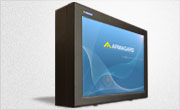Four Aspects to Outdoor Digital Signage Protection
Posted by: Richard Williams | Posted on: | 0 Comments
Using screens outdoors for advertising, information or branding is a technical challenge. LCD screens were not originally designed for outdoor use, and while LCD enclosures and outdoor TV systems are now commonly used in outdoor areas, not all systems provide the comprehensive protection necessary for outdoor digital signage.
For a screen to function in an outdoor environment four essential aspects of protection need considering.
Weather
Perhaps the most obvious form of protection required for an outdoor screen is protection from the weather. TV screens are not naturally waterproof so the screen needs protecting from rainfall and other elements.
Whether you are using a specific outdoor TV or an LCD enclosure the unit needs complete waterproofing, otherwise any moisture getting inside the device will lead to failure.
Temperature
Another consideration for any outdoor digital signage is the operating temperature the screen will work in. Not only will the ambient temperatures affect the screen, but also modern LCD and plasmas produce their own heat when in operation so transferring away excess heat is essential.
If ambient temperatures get very high, extreme measure like air-conditioning need considering, while in winter climates when temperatures plummet below zero the opposite problem occurs and thought needs to go into keeping the screen warm.
Physical Protection
Another consideration for an outdoor screen is protecting the device from physical impacts and attempts at vandalism. Screens in outdoor areas are often left unattended so both the screen face and the unit itself need adequate protection.
Shatterproof screens and a solid enclosure housing the display are essential to prevent damage and screen downtime.
Sunlight
Sunlight is another problem for outdoor screens. Not only can sunlight cause the screen to become unreadable, with the glare and brightness of the sun over-powering the screen image, but also direct sunlight can cause a screen face to burn or scorch.
Using high brightness screens and anti-reflective filters may help the screen image but to protect the screen from continuous sunlight shining on it, cooling systems on the screen face need employing to ensure the screen doesn’t burn.
Post shortlink:
Popular Products
LCD Enclosure
Need armor for your LCD/LED screen(s)? Outdoors or inside the versatile LCD enclosure protects against thieves, vandals & the weather. Installation idea: NFL stadiums.
Outdoor Digital Signage
Exclusive 46” outdoor screen protection. Dubbed the ‘Totem’, due to its distinct design, it repels damage threats, but attracts audiences. Installation idea: Drive-thru restaurants.
Portrait Flat Panel Enclosure
Safeguard your eye-level advertising display screen(s), indoors or outdoors. Completely customizable, add exciting features like touch screen technology. Installation idea: Restaurant frontages.
Indoor Digital Signage
Popular purchase for retail outlets! Great for ‘point of sale’ persuasion, boost your brand with static & motion advertising from a single unit! Installation idea: Mall of America.




